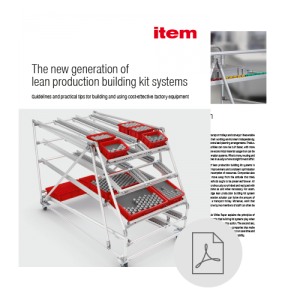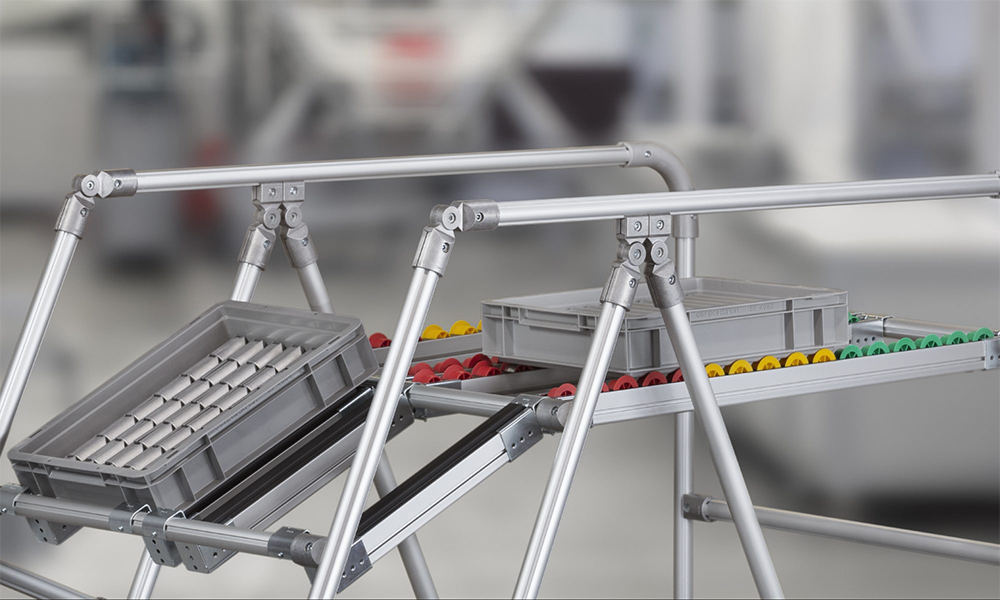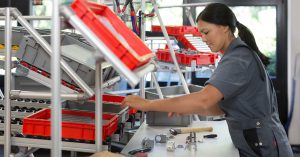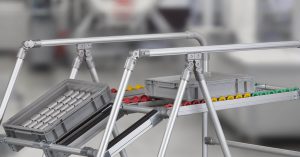Whether you’re looking for a basic introduction to lean production or want to refresh your memory – this easy-to-follow explanation will tell you what you need to know.
Let’s start with the definition. Lean production is a philosophy of continuous improvement. The aim is to reduce throughput times in production. Throughput refers not only to production itself – it also includes idle periods in between individual processes or during storage, for example. Fundamentally, throughput times and productivity are very closely linked – companies that succeed in reducing throughput times also see their productivity increase. Other associated benefits include high product quality, low costs and dedicated flexibility. However, anybody looking online for a definition of lean production will also come across claims that lean production is all about managers making job cuts. Definitions like this give the wrong impression, because lean production is in fact a growth strategy. Cutting throughput times means more and more customer orders and, as a result, bigger market shares, too. Which customer wouldn’t want short and reliable delivery times? Ultimately, sales also rise, meaning that more products need to be manufactured – so instead of cutting jobs, companies actually need to take on additional staff.

The world of lean production
Less waste and more added value – lean production methods let you make targeted improvements to your production efficiency. Our white paper provides a concise introduction.
DOWNLOAD NOW
The lean production concept – what it means and the story behind it
The actual term “lean production” is attributable to the reference book called “The Machine That Changed the World: The Story of Lean Production” (1990) by James P. Womack, Daniel Roos and Daniel T. Jones. The authors of what is commonly referred to as the “MIT study” used the term “lean production” to describe the Toyota Production System, which had led to a spectacular boom for Toyota and other companies in the Japanese automotive industry. However, before the publication of the MIT study, the Western world had scarcely paid any attention to the Toyota Production System that had been developed in the 1950s.
It’s important to note that lean management emerged from lean production – and not the other way round.
It’s not uncommon to read that lean production is a subdomain of lean management. This is true to some extent, since lean management takes account of the entire organisation with a view to holistic optimisation processes. This is why lean management has also been a business management principle for many years now. It’s important to note, however, that lean management emerged from lean production – and not the other way round. There are also specialist disciplines – lean administration and lean accounting – that aim to optimise processes in these areas. However, the term “lean manufacturing”, which is also common, is merely a synonym for lean production.
What is the Kaizen principle?
The basic philosophy of lean production is one of continuous improvement, which is based on the traditional Japanese concept of “Kaizen”. Kaizen is made up of the Japanese words for “change” (Kai) and “for good” (Zen), which suggests that improvement is a never-ending process. Consequently, it is never possible to be truly satisfied with what has been achieved – there is always a goal to be pursued further. This can also be understood within the context of a positive error culture in a company. Moreover, all parts of a process are relevant. As Swedish manager Jan Carlzon put it in a nutshell: “You cannot improve one thing by 1000 percent but you can improve 1000 little things by 1 percent.”
What’s the difference between Kaizen and CIP?
The Kaizen philosophy, which has long since been part of the standard production repertoire, lives on today all round the globe in the form of the continuous improvement process (CIP). The difference between Kaizen and CIP is therefore that Kaizen is a fundamental attitude, whereas CIP is a concrete methodology of lean production. The repeated PDCA cycle is key to the continuous improvement process. It consists of four steps: Plan, Do, Check and Act. Above all, it comes down to a hands-on mentality and an experimental approach. Using the PDCA cycle involves formulating a hypothesis and putting it to the test. If it turns out that the conjecture is correct, the corresponding optimisation measure then becomes the standard. This illustrates that changes made autonomously by employees are very much part of the continuous improvement process. Definitions and explanations of lean production often lose sight of this aspect.
With a solution such as the Lean Production Building Kit System from item, transport trolleys, shelves and other factory equipment for lean processes can be created in just a few simple steps.
When it comes to implementation, employees need more than simply an excellent introduction to rolling out lean production and the relevant competencies – they also have to be provided with the correct equipment. With a solution such as the Lean Production Building Kit System from item, for example, transport trolleys, shelves and other factory equipment for lean processes can be created in just a few simple steps. Companies should ideally provide the production facility with its own CIP workshop for making repeated improvements. Thanks to the modularity and flexibility of the Building Kit System, staff can regularly try out new approaches. In this context, even mistakes or errors are tolerable – and it is precisely small improvements that form important building blocks for CIP as a whole.

Explanation – waste within the context of lean production
As already described in the definition above, the aim of lean production is to reduce throughput times. Consequently, there has to be a factor that increases them – and that therefore needs to be reduced. Taiichi Ōno (1912–1990), who invented the Toyota Production System and thus played a key part in shaping the lean production concept, kept a very close eye on throughput times: “All we are doing is looking at the time line, from the moment the customer gives us an order to the point when we collect the cash. And we are reducing the time line by reducing the non-value adding wastes.” When it comes to precisely describing and defining these wastes during the manufacture of products, lean production has special terms and associated explanations. It all comes down to the 3Ms: Muda, Mura and Muri. Muda means “waste”, Mura “imbalance” and Muri “overloading”.
In lean production, Muda includes all activities that don’t add value.
Mura causes imbalanced, unstable processes. Since this can result in both Muda and Muri, Mura is also described as the actual source of waste. Nevertheless, Muda continues to be the term that is most widely known. This is undoubtedly due to the clarity of the 7 Muda, which are also known as the 7 types of waste. In the lean production philosophy, these include all activities that don’t add value in production. The seven types of waste are therefore useful for understanding how the concept of lean production is put into practice. Here are the 7 Muda and associated countermeasures:
- Superfluous movement of materials
Although resources are needed to transport materials, no value is added. What’s more, material damage can be incurred during transportation.
Solution: Work stations are positioned in closer proximity to one another and work steps are synchronised and interlinked if possible.
- High stock levels in the warehouse
An overfilled warehouse is a sign of both sub-optimal planning and a lack of understanding about the quantities of materials needed.
Solution: Processes are stabilised and, above all, standardised.
- Unergonomic movements
If ergonomic principles are not observed during work bench design in production, meaning staff end up having to work in awkward positions, this has a negative impact in two ways – employees’ health suffers and it takes them much longer to complete their tasks.
Solution: Assimilating ergonomic principles and using an ergonomic Work Bench System.
- Avoidable waiting times
Even though waiting times can’t be eliminated entirely, they should be prevented wherever possible, since no value can be added during these periods.
Solution: Staff are deployed to full capacity (by ensuring they can cover various different stations, for example) and take on additional tasks.
- Overproduction
Capital is tied up for too long because demand has been incorrectly assessed. Over time, product materials may also deteriorate while they are in the warehouse.
Solution: The pull principle is established – in other words, the process chain is synchronised with the customer takt time.
- Overly complex processes/overengineering
Waste is also produced by processes that are outdated or unnecessarily complex. A design that far exceeds the functionality of a product doesn’t add value either.
Solution: Focus on continuous improvement and scrutinise company processes.
- Rejects and reworking
When production errors occur, the results of the work are either completely unusable or else need to be re-engineered.
Solution: Use of measures to increase product quality, e.g. by optimising the work bench via the 5s method and preventing errors through application of the Poka-Yoke principle.
Lean production benefits explained on the basis of the pull principle
Waste avoidance is therefore one of the key benefits of lean production. It goes hand in hand with an increase in added value and considerate use of factors of production. This becomes particularly clear when we look at the example of the pull principle. In contrast to the traditional push principle, the pull principle involves management of a single process. Kanban is the best-known implementation of the pull principle. The information flow and the product flow run in opposite directions to one another. In concrete terms, this works as follows: The customer’s order triggers the production process and each production cell informs the one upstream of it what it requires.
The pull principle offers an effective way of reducing waste caused by overproduction and warehousing. Throughput times are made shorter, too.
Based on this information, each station produces what the next one needs. When production follows the pull principle, it is therefore not based on estimated needs, as it is in the case of the push principle. Instead, the target always reflects current needs, which offers the additional benefit of flexibility. This is an effective way of avoiding waste due to overproduction and warehousing. Throughput times are made shorter, too. Equally, however, Kanban is only the start of optimisation with the pull principle. As part of the continuous improvement process, Kanban is followed by the FIFO principle and assembly line production with one-piece flow. Throughput times and stock levels are lowest with one-piece flow because there is no interim buffering.
Lean production – definitions and explanations of key methods
Topics relating to all aspects of production organisation with the help of lean production have always played a key part in the item blog. As a result, a wealth of knowledge has been built up over the years that can provide companies with valuable inspiration. Here is a selection of definitions and explanations of key lean production methods:
- Visual management: 5s and Poka-Yoke
- Heijunka: Levelled production
- Six Sigma: Quality management based on statistics
- Just-in-time –logistics timed perfectly
- Just-in-sequence – for more precise procurement logistics
- The PDCA cycle – getting better bit by bit
- One-piece flow – the direct way to lean production
- The role of Kanban in lean production
- Production management – a comparison of the push and pull principles
Are you interested in fascinating reports and innovations from the world of lean production? Then we have just what you’re looking for! Simply subscribe to the item blog by completing the box at the top right.





